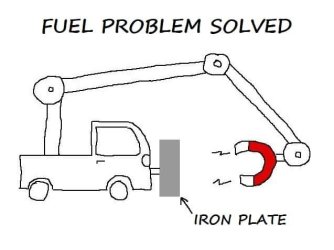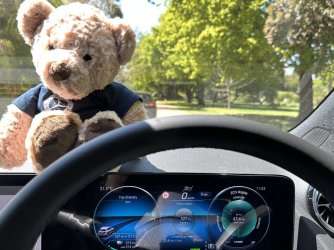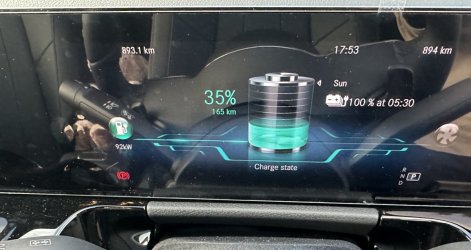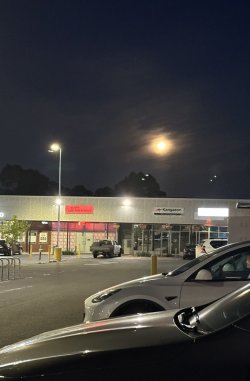You are using an out of date browser. It may not display this or other websites correctly.
You should upgrade or use an alternative browser.
You should upgrade or use an alternative browser.
General EV Discussion
- Thread starter Cruiser Elite
- Start date
Quickstatus
Enthusiast
- Joined
- Oct 13, 2013
- Posts
- 17,189
Bidirectional is going to be the next major evolution.
They will need to get battery longevity up a bit more though. Not long...
They will need to get battery longevity up a bit more though. Not long...
Cruiser Elite
Enthusiast
- Joined
- Oct 31, 2010
- Posts
- 14,429

12 US States Are Planning to Ban the Sale of Gas-Powered Cars
To curb tailpipe emissions and boost EV and plug-in hybrid sales, California is working toward banning the purchase of combustion cars. Eleven more US states announced plans to follow suit.
TheRealTMA
Senior Member
- Joined
- Jul 13, 2012
- Posts
- 8,337
- Qantas
- Platinum
Steady
Senior Member
- Joined
- Feb 3, 2013
- Posts
- 9,814
- Qantas
- LT Gold
Are there many LP Gas cars in OZ now? I assume most are Petrol, Diesel, or electric?
12 US States Are Planning to Ban the Sale of Gas-Powered Cars
To curb tailpipe emissions and boost EV and plug-in hybrid sales, California is working toward banning the purchase of combustion cars. Eleven more US states announced plans to follow suit.www.cnet.com
(
Been steadily declining since the govt put fuel excise tax on it in 2011, then scrapped the subsidy rebates, Ford Falcon and Holden Commodore stopped production in 2015 ish and Toyota Prius and other Hybrids started appearing and gaining market in taxis and fleets.
There is still a bit of use in VIC and NSW but most other centres where freight increases the LPG price are lucky to have 1 single LPG bowser anymore...and therefore the price is closer to petrol so nobody wants to use it anyway. Then the service station gets redeveloped and they DONT re-install any LPG pumps.
Its definitely dying if not dead.
Fully electric cars are not that popular in rural Aust due to range anxiety and lack of charging places, hybrids are the most popular atm for fuel savings. But if you can afford it we still love our big V8's as well...except now they are all imported.
There is still a bit of use in VIC and NSW but most other centres where freight increases the LPG price are lucky to have 1 single LPG bowser anymore...and therefore the price is closer to petrol so nobody wants to use it anyway. Then the service station gets redeveloped and they DONT re-install any LPG pumps.
Its definitely dying if not dead.
Fully electric cars are not that popular in rural Aust due to range anxiety and lack of charging places, hybrids are the most popular atm for fuel savings. But if you can afford it we still love our big V8's as well...except now they are all imported.
- Joined
- Mar 26, 2017
- Posts
- 2,551
- Qantas
- LT Gold
- Virgin
- Gold
We're down in Melbourne for the weekend, and managed to get hold of a BYD Atto 3 from Sixt. Originally they didn't have any available to book, but I asked at the desk and they had one available. The price is the same as the Kia Cerato I had booked, but of course there won't be any fuel cost.Also for thise not aware, SIXT right now has some pretty decent rental prices for EV rentals (they typically have BYD Atto3, Tesla M3 or Y) with free charging. It's definitely cheaper than equivalent sized ICE cars I've found.
If you're going away for a period and need a vehicle or even just looking to test for a day trip, this can be a good option to see if you like the vehicles for more than just a 30min test drive.
Personally I tried a Tesla Y last weekender to LST. Which came in at about $110 per day before extras.
Besides taking 15 minutes to work out what the different buttons and switches did, it's been a very impressive vehicle to drive. The ride is a bit stiff, but acceptable over the many bumps, speed bumps, tram tracks we've encountered. The view from the driver's seat is good, the steering light but precise and the brakes good. It only took a little while to get used to the way the power is delivered.
I would certainly consider buying one.
Yearlylonghaul
Junior Member
- Joined
- Mar 29, 2022
- Posts
- 45
- Qantas
- Silver
I don't understand why you would think that it is a niche situation.Just curious, but is it really necessary for 700?
Id imagine the niche situations where going from 500-700 is needed is quite few and far in between.
I live in a regional centre in NSW but travel frequently into rural NSW, VIC and SA in my cars. Many of the places where I travel and stay do not have EV chargers. For example Ungarie NSW, Lower Light SA, Box Ridge NSW, Stawell and Great Western Vic do not have public chargers. I use my vehicle every day to travel in the region (not going anywhere near a public charger) and can purchase unleaded and diesel when travelling in the areas but could not refuel my electric car if I had one.
I know many people that have travelling lifestyle similar to me, so requiring at least 500 to 700km range is not a niche situation.
prozac
Senior Member
- Joined
- Jan 7, 2010
- Posts
- 6,143
I'd consider a hybrid, but never an EV. Battery replacement cost is not prohibitive. Not so long ago I contracted to source refined lithium for a battery manufacturer. The major US supplier required payment on placement of order and wait time was 12-15 months. Hydrogen is coming and will be relatively easy to roll out as every servo can be converted to infrastructure. Fill your vehicle in same time as topping up your current fuel tank.
jamesatfish
Active Member
- Joined
- Apr 9, 2008
- Posts
- 722
We have a Porsche Taycan, which would have to be the worlds least efficient electric car. Massive 94kWh battery, about 320km highway cruising range.The most common question/comment I’ve had is ‘what if you need to do a long trip?’
Last year we took it from Canberra to the Gold Coast for a couple of days away.
The 1150km trip each way took 13 hours elapsed time door to door, including charging time.
Allowing for normal food and rest stops I don’t think that’s too much longer than a petrol or diesel car would need, even one with a fuel range long enough to do the distance without topping up the tank.
- Joined
- Nov 13, 2019
- Posts
- 476
- Qantas
- Platinum
- Oneworld
- Emerald
Taking my EV on Great Ocean Road trip last weekend requires detailed planning as out that way not many pubic chargers and not even many supercharges except the Tesla one at the Colac Coles plaza. Ultimately ended up going back via Colac at the end of each day to charge up. Stayed at Lorne two nights which had barely and public charger. Can’t risk if if not wanting to sit around the next day hoping for a charge. But with good planning trip is doable even when there’s not a lot of superchargers around.
First day drive was first to Colac and checking out the supercharger. We had lunch reservations at Brae so double backed after a brief explore of Colac. The car started with 100% battery. Arrived at Colac 152km, 2H:12M with 314kms remain approximately 65% battery. Top up charge at Colac later after driving back from Brae had battery close to 55%. Charged it back to 90%. Took about 20-25 mins and $25. Drove on to Lorne which was our base for the weekend. Got to Lorne’s and the sungle public charger was occupied! It was not a supercharger. So it was a good thing I topped the car up before. So used the hotel 10A charger to top up rest of battery overnight ready for the longer drive trip along the second half of great ocean road.
Day 2 is driving from Lorne to Apollo Bay along the coast. A stop to explore this wonderful town. Then turn inland up the Otway ranges to Port Campbell to 12 Apostles stoping at each sight until the Grotto. Then we drove back to Colac via Timboon for ice-cream one of the best especially apple pie flavor, then onto coorimungle for chocollate before turning the car towards Colac. By this time the car battery is around 30% and we travelled around 300kms. Charge back to 85% as the next day was just a slow drive back to Melbourne via Torquay. Cost this time to recharge is $30 for 37kW/h and about 30mins.
Day 3 is a simple slow meandering drive back to Melbourne after dropping into the other sights near Lorne. Dropped into the Torquay RACV resort to top up the car at the Chargefox supercharger. Only one was working of the two available. The 22kw charger one is broken and the other was on the blink. This time charge is free as Merc pay for this for the first 3 years.
So, what I learnt is that really need to identify alternate places to charge up as not always available for various reasons. Preferably supercharges to reduce downtimes, plan routes that start or finish to those nearby or when a break in the travel is required. Placement of cables can be tricky for supercharges as the cables are not very long and depends where the location to plug into car can be tricky. Tesla ones are suited n oriented to the Tesla cars on the left of the boot when parked facing forward. There is a few apps that can help identify chargers. I used plug share. It was very useful to work out availability.
Overall, the trip was a success and with good planning not much time was wasted due to charging including the drive back to Colac before heading back to Lorne. Either way just added a further 50kms to each time as my visits around that area took me back quite close to Colac before looping back to Lorne. The half hour stop in the Coles car park flew past. I had an excuse to stop for dinner at Forrest brewing for dinner second night on the way back to Lorne.
The EQA is a joy to drive it just glides. The driver aids and assist etmakes it almost automated other than to steer n brake n apply power. The power is smoothly delivered the acceleration is quick enough has ice cars beaten anytime even on the hills although there’s not much point because there’s a slow car in the front each time. New driving style required helps conserve battery. Which I soon worked out.
No going back …. EV for me now.
First day drive was first to Colac and checking out the supercharger. We had lunch reservations at Brae so double backed after a brief explore of Colac. The car started with 100% battery. Arrived at Colac 152km, 2H:12M with 314kms remain approximately 65% battery. Top up charge at Colac later after driving back from Brae had battery close to 55%. Charged it back to 90%. Took about 20-25 mins and $25. Drove on to Lorne which was our base for the weekend. Got to Lorne’s and the sungle public charger was occupied! It was not a supercharger. So it was a good thing I topped the car up before. So used the hotel 10A charger to top up rest of battery overnight ready for the longer drive trip along the second half of great ocean road.
Day 2 is driving from Lorne to Apollo Bay along the coast. A stop to explore this wonderful town. Then turn inland up the Otway ranges to Port Campbell to 12 Apostles stoping at each sight until the Grotto. Then we drove back to Colac via Timboon for ice-cream one of the best especially apple pie flavor, then onto coorimungle for chocollate before turning the car towards Colac. By this time the car battery is around 30% and we travelled around 300kms. Charge back to 85% as the next day was just a slow drive back to Melbourne via Torquay. Cost this time to recharge is $30 for 37kW/h and about 30mins.
Day 3 is a simple slow meandering drive back to Melbourne after dropping into the other sights near Lorne. Dropped into the Torquay RACV resort to top up the car at the Chargefox supercharger. Only one was working of the two available. The 22kw charger one is broken and the other was on the blink. This time charge is free as Merc pay for this for the first 3 years.
So, what I learnt is that really need to identify alternate places to charge up as not always available for various reasons. Preferably supercharges to reduce downtimes, plan routes that start or finish to those nearby or when a break in the travel is required. Placement of cables can be tricky for supercharges as the cables are not very long and depends where the location to plug into car can be tricky. Tesla ones are suited n oriented to the Tesla cars on the left of the boot when parked facing forward. There is a few apps that can help identify chargers. I used plug share. It was very useful to work out availability.
Overall, the trip was a success and with good planning not much time was wasted due to charging including the drive back to Colac before heading back to Lorne. Either way just added a further 50kms to each time as my visits around that area took me back quite close to Colac before looping back to Lorne. The half hour stop in the Coles car park flew past. I had an excuse to stop for dinner at Forrest brewing for dinner second night on the way back to Lorne.
The EQA is a joy to drive it just glides. The driver aids and assist etmakes it almost automated other than to steer n brake n apply power. The power is smoothly delivered the acceleration is quick enough has ice cars beaten anytime even on the hills although there’s not much point because there’s a slow car in the front each time. New driving style required helps conserve battery. Which I soon worked out.
No going back …. EV for me now.
Attachments
Cruiser Elite
Enthusiast
- Joined
- Oct 31, 2010
- Posts
- 14,429
Beijing for 4 days and now Shanghai 2 days and counting - EVs in China WOW - just WOW.
Google Beijing Electric Taxis and Roewe Electric Taxis in be Shanghai - WOW - just WOW.
Beijing air is cleanest I have ever smelt - no longer can you smell the exhaust fumes - just WOW.
Google Beijing Electric Taxis and Roewe Electric Taxis in be Shanghai - WOW - just WOW.
Beijing air is cleanest I have ever smelt - no longer can you smell the exhaust fumes - just WOW.
anat0l
Enthusiast
- Joined
- Dec 30, 2006
- Posts
- 12,298
- Qantas
- Platinum
- Virgin
- Red
- Oneworld
- Emerald
- Star Alliance
- Gold
I'm about to consider my next vehicle to replace my Suzuki Swift.
Looking at a BYD Atto 3 on my salary packaging.
The price looks pretty good for the form factor. Test driving it seems the most intuitive coming from driving a ICE vehicle, but my EV test driving has been limited to Tesla (Model 3 and Y) and BYD, plus I drove a Polestar 2 as a hire car for a weekend (nice and smooth, but it is much more expensive).
Looking at a BYD Atto 3 on my salary packaging.
The price looks pretty good for the form factor. Test driving it seems the most intuitive coming from driving a ICE vehicle, but my EV test driving has been limited to Tesla (Model 3 and Y) and BYD, plus I drove a Polestar 2 as a hire car for a weekend (nice and smooth, but it is much more expensive).
anat0l
Enthusiast
- Joined
- Dec 30, 2006
- Posts
- 12,298
- Qantas
- Platinum
- Virgin
- Red
- Oneworld
- Emerald
- Star Alliance
- Gold
Might have been discussed upthread, but what is everyone's strategy when it comes to charging their EV?
For whatever it is worth, my workplace doesn't have EV chargers or many (or any) spots for EVs (i.e. near a power socket). (All of our parking spots are allocated, so we park wherever we are given and that's that)
I can see a few approaches:
Finally, I think, like most batteries, would people ensure their batteries are nearly always between 20-90% only? Has anyone ever driven their EV down to lower than 10% or even 5%?
For whatever it is worth, my workplace doesn't have EV chargers or many (or any) spots for EVs (i.e. near a power socket). (All of our parking spots are allocated, so we park wherever we are given and that's that)
I can see a few approaches:
- Charge at home, straight into your 240 V. Racks up costs on your electricity bill, but still cheaper than fuel.
- Charge at EV charging spots around the place, using Chargefox or PlugShare to locate spots.
- Charge at supercharging spots every so often, similar to the cycle of refuelling an ICE car.
Finally, I think, like most batteries, would people ensure their batteries are nearly always between 20-90% only? Has anyone ever driven their EV down to lower than 10% or even 5%?
+1 game-changerBidirectional is going to be the next major evolution.
10-20 years not enough for you?They will need to get battery longevity up a bit more though. Not long...
33kft
Established Member
- Joined
- Jun 19, 2018
- Posts
- 2,184
- Qantas
- Platinum
- Virgin
- Gold
- Oneworld
- Emerald
No, you need to consider time cost. I signed up to OVO's EV plan. It gives me 8c per kWh between 12am and 6am daily. That means to charge my car completely it would cost me $4. For that sort of money, I'm not going to go hunt a free charger when I can just plug it in when I get home and have scheduled charging charge it overnight for me.Does anyone here aim for charging their vehicle free of charge (i.e. search for charging spots that don't cost anything for the charging)?
Where I would use free charging is if I went to the shops or for a meal and I found an available charger. That way I might skip one night of charging. Keep in mind that $4 is for a full charge, a quarter charge might cost me $1 at home and that's likely what I am going to save at a free charger, so I ain't going out of my way to find one.
Quickstatus
Enthusiast
- Joined
- Oct 13, 2013
- Posts
- 17,189
No, biderectional use will actually increase cyclic ageing.10-20 years not enough for you?
33kft
Established Member
- Joined
- Jun 19, 2018
- Posts
- 2,184
- Qantas
- Platinum
- Virgin
- Gold
- Oneworld
- Emerald
This is a bit of a two-part question. Yes, it is good practice to keep your battery SoC within a certain range and depending on the battery chemistry that might be 10-80% (ie NCA) or 10-100% (LFP) and all EVs that I am aware of will give this guidance via their in car systems so you won't be confused as to what is optimal.Finally, I think, like most batteries, would people ensure their batteries are nearly always between 20-90% only? Has anyone ever driven their EV down to lower than 10% or even 5%?
As for anyone having gone outside of this range, I have plenty of times. I'm not going to tell you it's good practice and I loathe discussing it to be honest as people have some very strong opinions on these topics but for my car the battery doesn't keep me up at night and if I am driving back home and can make it without a stop and arrive with 1% or 0% (yes this has happened a few times) I will happily do that. A lot of us do cut it fine but keep in mind I'm talking about EV owners of 4+ years now who have become very much accustomed to how their car performs. This isn't a general piece of advice.
Also keep in mind that once I get where I am going at 5% or 0% whatever it may be, I'll immediately charge it back up because leaving it there would be unnecessary and not optimal and because it's a car and a car with 0% charge is not very useful.
Realistically though, this will not damage your battery in any meaningful way. It isn't optimal, and the point of all of these practices is to keep to optimal practice and keep degradation to a minimum, but there's a lot of BS and overemphasis of minor things and you will find in the long run that these batteries are much more tolerant and resilient than people believe to be the case, particularly with modern BMS and thermal management of the batteries.
Last edited:
UP4014
Senior Member
- Joined
- Jul 22, 2008
- Posts
- 6,900
We have a Porsche Taycan, which would have to be the worlds least efficient electric car. Massive 94kWh battery, about 320km highway cruising range.
Last year we took it from Canberra to the Gold Coast for a couple of days away.
The 1150km trip each way took 13 hours elapsed time door to door, including charging time.
Allowing for normal food and rest stops I don’t think that’s too much longer than a petrol or diesel car would need, even one with a fuel range long enough to do the distance without topping up the tank.
I prefer to choose my routes to and from, not have to travel a route defined by power points.
Post automatically merged:
Just curious, but is it really necessary for 700?
Id imagine the niche situations where going from 500-700 is needed is quite few and far in between.
Yep, I am one of those people who want 700 plus, enjoy regional long distance trips.
Elevate your business spending to first-class rewards! Sign up today with code AFF10 and process over $10,000 in business expenses within your first 30 days to unlock 10,000 Bonus PayRewards Points.
Join 30,000+ savvy business owners who:
✅ Pay suppliers who don’t accept Amex
✅ Max out credit card rewards—even on government payments
✅ Earn & transfer PayRewards Points to 10+ airline & hotel partners
Start earning today!
- Pay suppliers who don’t take Amex
- Max out credit card rewards—even on government payments
- Earn & Transfer PayRewards Points to 8+ top airline & hotel partners
Join 30,000+ savvy business owners who:
✅ Pay suppliers who don’t accept Amex
✅ Max out credit card rewards—even on government payments
✅ Earn & transfer PayRewards Points to 10+ airline & hotel partners
Start earning today!
- Pay suppliers who don’t take Amex
- Max out credit card rewards—even on government payments
- Earn & Transfer PayRewards Points to 8+ top airline & hotel partners
AFF Supporters can remove this and all advertisements
ayebee
Active Member
- Joined
- Jan 20, 2015
- Posts
- 675
- Qantas
- LT Silver
Ours is "just" a PHEV, but ...Might have been discussed upthread, but what is everyone's strategy when it comes to charging their EV?
For whatever it is worth, my workplace doesn't have EV chargers or many (or any) spots for EVs (i.e. near a power socket). (All of our parking spots are allocated, so we park wherever we are given and that's that)
I can see a few approaches:
Does anyone here aim for charging their vehicle free of charge (i.e. search for charging spots that don't cost anything for the charging)?
- Charge at home, straight into your 240 V. Racks up costs on your electricity bill, but still cheaper than fuel.
- Charge at EV charging spots around the place, using Chargefox or PlugShare to locate spots.
- Charge at supercharging spots every so often, similar to the cycle of refuelling an ICE car.
Finally, I think, like most batteries, would people ensure their batteries are nearly always between 20-90% only? Has anyone ever driven their EV down to lower than 10% or even 5%?
we only charge at home timed for when the solar is producing.
Being retired, we don't have the constraint of needing to find a daytime charge away from home.
I did some calculations that suggested the cost of fuel was roughly equivalent to a commercial charger given typical kWhr prices. So away from home we don't bother even looking for a charge.
The Victorian ZLEV tax is an annoying overhead either way.
It will be interesting to hear the high court decision on Wednesday in the appeal against the Victorian tax.
I suspect it will fail as difficult to see a per km tax as an "excise", even though we pay both ways and in fact more than if we had a non-plug in hybrid.
Become an AFF member!
Join Australian Frequent Flyer (AFF) for free and unlock insider tips, exclusive deals, and global meetups with 65,000+ frequent flyers.AFF members can also access our Frequent Flyer Training courses, and upgrade to Fast-track your way to expert traveller status and unlock even more exclusive discounts!

AFF forum abbreviations
Wondering about Y, J or any of the other abbreviations used on our forum?Check out our guide to common AFF acronyms & abbreviations.






















